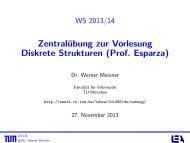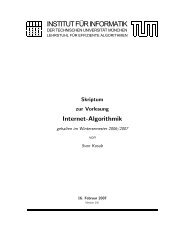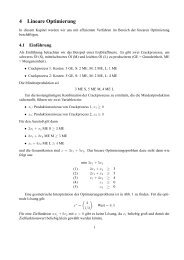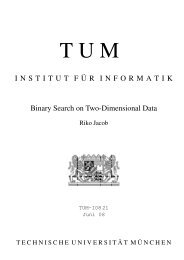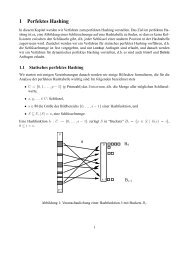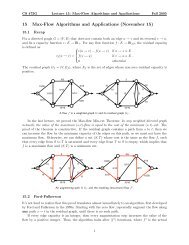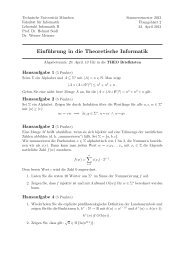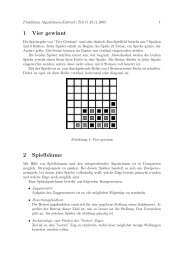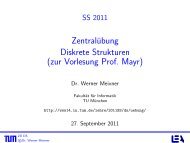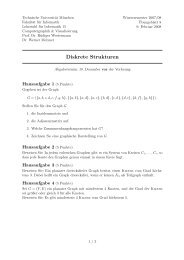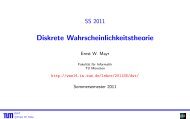Time-dependent networks as models to achieve fast exact time-table ...
Time-dependent networks as models to achieve fast exact time-table ...
Time-dependent networks as models to achieve fast exact time-table ...
You also want an ePaper? Increase the reach of your titles
YUMPU automatically turns print PDFs into web optimized ePapers that Google loves.
<strong>Time</strong>-<strong>dependent</strong> <strong>networks</strong> <strong>as</strong> <strong>models</strong> <strong>to</strong> <strong>achieve</strong>f<strong>as</strong>t <strong>exact</strong> <strong>time</strong>-<strong>table</strong> queriesGerth Stølting Brodal ∗Riko Jacob ∗30th April 2002AbstractWe consider efficient algorithms for <strong>exact</strong> <strong>time</strong>-<strong>table</strong> queries, i.e. algorithmsthat find optimal itineraries. We propose <strong>to</strong> use <strong>time</strong>-<strong>dependent</strong><strong>networks</strong> <strong>as</strong> a model and show advantages of this approach over space-<strong>time</strong><strong>networks</strong> <strong>as</strong> <strong>models</strong>.1 IntroductionFinding the optimal itinerary for a traveler using public transportation is analgorithmic challenge. Using standard algorithms <strong>to</strong> solve itinerary queries on<strong>time</strong><strong>table</strong>s of interesting detail and size e<strong>as</strong>ily leads <strong>to</strong> unacceptably slow answers,even on modern computers. In practice this problem is overcome byusing a heuristic solver, that is a solver that quickly computes results, that arenot guaranteed <strong>to</strong> be optimal. Our focus here is instead <strong>to</strong> produce optimalitineraries.The nature of an optimal itinerary query is that of a shortest path question.The natural approach <strong>to</strong> solve it is <strong>to</strong> transform the <strong>time</strong><strong>table</strong> in<strong>to</strong> some weightedgraph (modeling <strong>as</strong> a space-<strong>time</strong> graph [PS97, PS98]), on which a shortest pathcorresponds <strong>to</strong> an optimal itinerary. This seems <strong>to</strong> be a standard approach,taken for example in [SWW99, MHW01]. In this setting we propose <strong>to</strong> use <strong>as</strong> amodel <strong>time</strong>-<strong>dependent</strong> graphs instead of weighted graphs. This kind of model iscloser <strong>to</strong> the <strong>time</strong>-<strong>table</strong> itself and allows the algorithm <strong>to</strong> immediately disregardlarge portions of the <strong>time</strong>-<strong>table</strong>.The key idea in a <strong>time</strong>-<strong>dependent</strong> network is that the <strong>time</strong>-delay of a linkdepends on the point in <strong>time</strong> the link is used. This model is natural in severalother situations, for example data-packets on the Internet or cars on a roadnetwork. This <strong>models</strong> the phenomenon, that the delay a link induces dependson the path that is used <strong>to</strong> reach this link. In general shortest path questionson such <strong>networks</strong> are hard <strong>to</strong> answer, but important special c<strong>as</strong>es allow forf<strong>as</strong>t algorithms. These kind of <strong>networks</strong> have been considered in the literature,see [OR90, OR91] for a survey.In [SWW99] the authors address the question, whether it is fe<strong>as</strong>ible <strong>to</strong> computeoptimal itineraries for the German railway system. They propose severalheuristic running <strong>time</strong> improvements that allow for sufficiently quick answers.∗ BRICS (B<strong>as</strong>ic Research in Computer Science, www.brics.dk, funded by the Danish NationalResearch Foundation), Department of Computer Science, University of Aarhus, NyMunkegade, DK-8000 Århus C, Denmark. E-mail: {gerth,rolf,rjacob}@brics.dk. Partiallysupported by the IST Programme of the EU under contract number IST-1999-14186(ALCOM-FT).
Our modeling is compatible <strong>to</strong> these heuristics, they can immediately be appliedin the <strong>time</strong>-<strong>dependent</strong> algorithms <strong>as</strong> well. We expect that our modelingand algorithmic approach will lead <strong>to</strong> significant running <strong>time</strong> improvementsthat allow for a bigger or more detailed network (including local busses, extending<strong>to</strong> all of Europe). For our lack of real world data the analysis of ourapproach is a theoretical comparison against [SWW99].We also consider an extensions of the algorithmic problem, that allows <strong>to</strong>restrict transfer.Some simple calculation about problem sizes and modern hardware showsthat it can be fe<strong>as</strong>ible <strong>to</strong> precompute the answers <strong>to</strong> all possible queries ands<strong>to</strong>re the result on a hard-disk. If the network size allows this, it can be a viablealternative <strong>to</strong> an algorithmic solution. This should be the c<strong>as</strong>e if the networkis not <strong>to</strong>o big. Of course this approach still needs <strong>to</strong> find f<strong>as</strong>t itinerary in apreprocessing step.1.1 The algorithmic problemAs already stated, we want <strong>to</strong> be able <strong>to</strong> produce optimal itineraries for p<strong>as</strong>sengers.That is, given the <strong>time</strong>-<strong>table</strong>s of all trains in the country, we want<strong>to</strong> pre-process this data in a way, that allows us <strong>to</strong> answer queries f<strong>as</strong>t. Weconsider queries of the form “given that the traveler is at station A at <strong>time</strong> t,when is the earliest <strong>time</strong> he can be at station B, and how can this be <strong>achieve</strong>d?”For simplicity we <strong>as</strong>sume that changing trains h<strong>as</strong> no induced costs, i.e. takesno <strong>time</strong> and can be done <strong>as</strong> often <strong>as</strong> necessary.We <strong>as</strong>sume that we have a set T that represents <strong>time</strong>. We only <strong>as</strong>sumethat we have a <strong>to</strong>tal ordering of the elements in T. Some<strong>time</strong>s we additionally<strong>as</strong>sume that ther is an addition operation defined over T.A <strong>time</strong>-<strong>table</strong> T is a set of train-connections. It is valid for a certain <strong>time</strong>period,its (<strong>time</strong>-)horizon. This is an interval of T. An event is a pair (a, t)where a ∈ S for some finite set S of stations, and t ∈ T. A train-connectionis a pair (e 1 , e 2 ), e 1 = (a 1 , t 1 ) the departure event and e 2 = (a 2 , t 2 ) the arrivalevent. We have that the <strong>time</strong> of the arrival event is not before the <strong>time</strong> of thedeparture event, i.e. t 1 ≤ t 2 .An itinerary in T is a sequence of events, more precisely an alternating sequenceof train departure and arrival events e 1 , e 2 , . . . , e k . Two events e 2i−1 , e 2ihave <strong>to</strong> be consecutive departure and arrival events of some train in T , twoevents e 2i , e2i + 1 have <strong>to</strong> be arrival and departure events at the same station.It will be common that T is not given explicitly, but for example <strong>as</strong> the<strong>time</strong>-<strong>table</strong> for one day and the additional information that this day is repeatedthroughout a certain period. Note that in a repetitive schedule there will beover-night connections that are not possible if the horizon is restricted <strong>to</strong> oneday.These definitions have some severe restrictions. At a station we can notdistinguish between continuing in the same train and transfer. We also disallowthe traveler <strong>to</strong> use any other means of transportation like walking 200 metersfrom one station <strong>to</strong> another. In Section 5 we will address these issues, allowingus <strong>to</strong> impose restrictions on the maximum number of transfers or accountingfor the <strong>time</strong> it takes <strong>to</strong> walk inside the station <strong>as</strong> part of a transfer.2 Using a space-<strong>time</strong> networkThe approach we describe is straightforward given how we made the algorithmicproblem precise. It is a direct transformation of a <strong>time</strong>-<strong>table</strong> in<strong>to</strong> a directed1
weighted graph. Paths in this graph are almost itineraries. To calculate theweights it is important that T allows for addition and subtraction.Given a <strong>time</strong>-<strong>table</strong> T we construct the graph G = (V, E) in the followingway: V is the set of all events of T . There is an edge from event e at stationa <strong>to</strong> the first event at station a after e. If the schedule is repetitive, this canbe reflected by having a link from the l<strong>as</strong>t event of the day at station a <strong>to</strong> thefirst event of the day at station a. If a pair of events (e 1 , e 2 ) is in T , there isa directed edge from e 1 <strong>to</strong> e 2 . The weight of an edge in the weighted graphmodel is given by the <strong>time</strong>-difference of its endpoints, i.e. the traveling <strong>time</strong> orthe waiting <strong>time</strong> at a station.This type of model can be seen <strong>as</strong> a space-<strong>time</strong> network <strong>as</strong> described in [PS97].It is the model used in [SWW99] and therefore important for us because we useit for a running <strong>time</strong> comparison we will present in Section 4.In [SWW99] this model is used and augmented with different heuristics thatimprove the running <strong>time</strong>. These heuristics immediately transfer <strong>to</strong> the <strong>time</strong><strong>dependent</strong>approach, and <strong>achieve</strong> running <strong>time</strong>s that allow <strong>exact</strong> <strong>time</strong>-<strong>table</strong>queries for the German railway system in a re<strong>as</strong>onable <strong>time</strong>. As we can strictlyimprove over this model this do-ability statement remains valid. The detailedcomparison of the two approaches is given in Section 4. We have also re<strong>as</strong>on <strong>to</strong>believe that our approach scales better, so we would expect it <strong>to</strong> be f<strong>as</strong>t enoughon even bigger or more detailed <strong>networks</strong>, e.g. including local buses and train<strong>as</strong> well and/or being precise about changing trains.In [SWW99] the authors observe that “CPU <strong>time</strong> looks linear <strong>to</strong> the numberof nodes (and thereby edges) explored.” This statement can be explained bycache behavior. If we <strong>as</strong>sume that the priority queue stays small enough <strong>to</strong>fit in<strong>to</strong> the CPU-cache, where<strong>as</strong> the graph is <strong>to</strong> big for that, we get that theCPU-<strong>time</strong>s are dominated by the cache-misses that correspond <strong>to</strong> accessing thegraph.Be aware that there are some obvious alternatives <strong>to</strong> this model. For example,one could deviate from the cycle of edges at one station and explicitly havean edge if a p<strong>as</strong>senger can actually change trains <strong>as</strong> suggested by a combinationof arrival/departure events. This model uses in general a lot more edges, butit allows for a much more detailed modeling. We could for example make surethat the walking inside the station actually allows the transfer.3 <strong>Time</strong>-<strong>dependent</strong> <strong>networks</strong>In this section we develop the terminology for <strong>time</strong>-<strong>dependent</strong> <strong>networks</strong> (orgraphs, which is precisely the same) and proof the correctness of a f<strong>as</strong>test pathalgorithm, that works in the situation we have here. We omit a discussion ofthe fe<strong>as</strong>ibility of shortest path questions in the more general setting, allowingnegative delays and/or non-mono<strong>to</strong>nic functions. In this more involved setting,it is important <strong>to</strong> specify a waiting policy. See [OR90, OR91] for a discussionof this type of network.The domain of <strong>time</strong> is again a linearly ordered set T. In this section we donot <strong>as</strong>sume that there is an addition operation defined on T. Typical examplesfor the set T are the real numbers and the integers, but also finite sets might beinteresting.A <strong>time</strong>-<strong>dependent</strong> network is a directed graph G = (V, E), where everyedge e h<strong>as</strong> an <strong>as</strong>sociated link-traversal function f e : T → T.Let f: T → T be a function. If f satisfies f(t) ≥ t for all t, we say thatf h<strong>as</strong> non-negative delay. If for t ≤ t ′ we have f(t) ≤ f(t ′ ), we say that f ismono<strong>to</strong>nic.2
In general it is important <strong>to</strong> be precise about the waiting policy for a travelerin such a network. This is not an issue here, <strong>as</strong> we are only interested in shortest/f<strong>as</strong>testpath in the network and encode all the necessity and possibility <strong>to</strong>wait in<strong>to</strong> the functions. More precisely, if we consider only mono<strong>to</strong>nic functionswaiting never pays off, the imposed restrictions on waiting is irrelevant. Themore general setting and the influence of different waiting policies is discussedin [OR90, OR91].Here we use the following simple definition of a <strong>time</strong>d path in G: A sequencev 1 , v 2 , . . . , v k ∈ V of nodes in G and a sequence t 1 , t 2 , . . . , t k ∈ T of <strong>time</strong>s form a<strong>time</strong>d path if e = (v i , v i+1 ) ∈ E is an edge of G and t i+1 = f e (t i ). The vertex v 1is called the departure location or source of the path, t 1 the departure <strong>time</strong>, v kthe destination and t k the arrival <strong>time</strong>.The earliest arrival question for a source node s, a destination d, and adeparture <strong>time</strong> t <strong>as</strong>ks for a <strong>time</strong>d path p from s <strong>to</strong> d of which the arrival <strong>time</strong>is minimal. Similarly the latest departure question is well defined if we fix anupper bound for the arrival <strong>time</strong>, i.e. we <strong>as</strong>k for a path that h<strong>as</strong> the latestdeparture <strong>time</strong> at s under the constraint that the arrival <strong>time</strong> is not after thespecified arrival <strong>time</strong>.Assume that we can (efficiently) evaluate the link-traversal functions of agraph and (efficiently) perform comparisons of elements in T. Then it is re<strong>as</strong>onable<strong>to</strong> consider a variant of Dijkstra’s algorithm <strong>to</strong> solve the earliest arrivalquestion. It is natural <strong>to</strong> analyze its running <strong>time</strong> <strong>as</strong> a number of functionevaluations, comparisons and operations of a (comparison b<strong>as</strong>ed) priority queueover T.Lemma 3.1 (All earliest arrival paths are simple) Let G be a finite <strong>time</strong><strong>dependent</strong>network with mono<strong>to</strong>nic and non-negative delay edge traversal functions.Let p be a <strong>time</strong>d path in G departing at <strong>time</strong> t at node s and arrivingat <strong>time</strong> t ′ at node d. Then there exists a simple <strong>time</strong>d path in G departing at<strong>time</strong> t at node s and arriving at <strong>time</strong> t ′′ at node d such that t ′′ ≤ t ′ .Corollary 3.2 (Earliest arrival path are well defined) Let G be a finite<strong>time</strong>-<strong>dependent</strong> network with mono<strong>to</strong>nic and non-negative delay edge traversalfunctions. Let s and d be two nodes of G, and a departing <strong>time</strong> t ∈ T. Thenthere exists t ′ ∈ T achieving the minimum arrival <strong>time</strong> at d over all <strong>time</strong>d pathsfrom s <strong>to</strong> d.Label setting algorithmLet Q be a priority queue over pairs from V × T, that allows <strong>to</strong> extract a pairwith a minimal element from T, i.e. a priority queue of points in <strong>time</strong> annotatedwith nodes.1: Static Input: G = (V, E), and for every e ∈ E a mono<strong>to</strong>nic, non-negativedelay link-traversal function f e : T → T.2: Dynamic Input: source node s ∈ V , destination node d ∈ V , departure<strong>time</strong> t ∈ T3: a[v] := ∞ for all v ∈ V4: a[s] := t5: S := ∅6: Q := {(s, t)}7: while Q ≠ ∅ do8: (u, t ′′ ):= extract min( Q )9: S := S ∪ {u}10: break while-loop if u = d3
11: for each edge (u, v) ∈ E such that v ∉ S do12: t ′ := f uv (a[u])13: if a[v] > t ′ then14: if a[v] = ∞ then15: insert( Q, v, t ′ )16: else17: update( Q, v, t ′ )18: end if19: a[v] := t ′20: pred[v] := u21: end if22: end for23: end while24: v := d25: p := (v, a[v])26: while v ≠ s do27: v := pred[v]28: p := (v, a[v]).p29: end while30: Output: pCorrectness of the algorithmThe above algorithm is correct, really for the same re<strong>as</strong>on <strong>as</strong> Dijkstra’s algorithmis correct for non-negatively weighted graphs. But <strong>as</strong> we did not find a proof ofcorrectness that would immediately apply in our situation, we give a completeproof.Define δ(s, t, u) <strong>to</strong> be the earliest possible arrival <strong>time</strong> at node u given thatwe departed at <strong>time</strong> t at node s, i.e. the minimum over all paths from s <strong>to</strong> udeparting at <strong>time</strong> t.The correctness of the algorithm follows from the fact that the invarianta[u] = δ(s, t, u) for all nodes u ∈ S holds before (and after) every execution ofthe body of the while loop.The way we update the estimates, we maintain the invariant that• pred[·] defines a tree R in G that is directed <strong>to</strong>wards s• Let p be a path that traverses only edges of R in the reverse direction.Then a[·] gives the <strong>time</strong>stamps that form <strong>to</strong>gether with p a <strong>time</strong>d pathdeparting at s at <strong>time</strong> t. For every node u ∈ R such a path exists.• a[u] ≥ δ(s, t, u)• For all u ∈ S we have a[u] = δ(s, t, u)Now <strong>as</strong>sume that we have e = a[u] > δ(s, t, u) = δ for some node u ∈ S.Without loss of generality we can <strong>as</strong>sume that u is the first (in the executionof the algorithm) such node, i.e. that for all other nodes v in S we have a[v] =δ(s, t, v).In this situation let p be some some earliest arrival path from s at <strong>time</strong> t <strong>to</strong>u. Let p(v) denote the <strong>time</strong> path p visits node v. Let y be the first vertex ofp that is outside of S and x its predecessor on p (inside S). By <strong>as</strong>sumption wehave a[x] = δ(s, t, x) and δ(s, t, x) ≤ p(x) follows <strong>as</strong> p induces a subpath from s<strong>to</strong> x that departs at <strong>time</strong> t and arrives at <strong>time</strong> p(x). When x w<strong>as</strong> inserted in<strong>to</strong>S the algorithm updated a[y], and <strong>as</strong> no update incre<strong>as</strong>es an estimate, we havea[y] ≤ f xy (δ(s, t, x)). As f xy is mono<strong>to</strong>nic, we can conclude that f xy (δ(s, t, x)) ≤f xy (p(x)) = p(y). As all link-traversal functions on the remaining path from y <strong>to</strong>4
u have non-negative delay, we have p(y) ≤ p(u) = δ. Putting these inequalities<strong>to</strong>gether, we get a[y] < a[u], which is a contradiction in the c<strong>as</strong>e u = y. In allother c<strong>as</strong>es, the algorithm would have chosen node y instead of node u <strong>as</strong> thenext node <strong>to</strong> add <strong>to</strong> S, which contradicts the definition of u.This argument also shows that we do not need <strong>to</strong> check v ∈ S at Line 13,because we will never find a node inside S where we can still improve a[u]. Thisis the only use of the set S. Depending on how expensive it is <strong>to</strong> evaluate alink-traversal function, it might or might not pay off <strong>to</strong> not maintain the set Sin the algorithm.3.1 Modeling a <strong>time</strong>-<strong>table</strong> lookup with a <strong>time</strong>-<strong>dependent</strong>networkLet T be a <strong>time</strong>-<strong>table</strong>. We describe how <strong>to</strong> construct a <strong>time</strong>-<strong>dependent</strong> networkG = (V, E, f). Then we chose the set of nodes V <strong>to</strong> be the set of stationsappearing in T . Let u and v be two stations. DefineC uv = {(t, t ′ ) | ((a, t), (b, t ′ ) ∈ T }that is for every direct connection from u <strong>to</strong> v there is a pair of <strong>time</strong>s in C uv .If C uv is empty, there is no arc from u <strong>to</strong> v. Otherwise we definef uv (t) = min{t ′′ | (t ′ , t ′′ ) ∈ C uv and t ≤ t ′ }.This function is mono<strong>to</strong>nic and of non-negative delay.Let I be an itinerary. Then we find a <strong>time</strong>d path p in G that is never laterat a certain station than I is. The path p is therefore a <strong>time</strong>d path that doesnot arrive later at the destination than I does.Let p be a <strong>time</strong>d path in G. By the definition of the link traversal functionswe know, that every link traversal of p corresponds <strong>to</strong> an entry of T .Concatenating those entries yields a valid itinerary.All in all we have that we can answer an itinerary query from s at <strong>time</strong> t<strong>to</strong> d on T by solving the earliest arrival problem on G with source s at <strong>time</strong> tand destination d.4 Implementation issuesThere are several speed-up techniques known for Dijkstra’s algorithm. Twocl<strong>as</strong>ses of such techniques are on-the-fly potential and pruning, <strong>as</strong> for exampleused in [SWW99].The most well known potential technique is <strong>to</strong> modify the value that isused in the priority queue by a lower bound on the remaining path-length <strong>to</strong>the destination. If the network is embedded in<strong>to</strong> the plane, this can be anappropriate multiplicative of the Euclidean distance <strong>to</strong> the destination. Oneway <strong>to</strong> convince oneself about the correctness of this method is <strong>to</strong> think ofmodifying the edge weights of the graph according <strong>to</strong> some potential, i.e. w uv ′ =w uv + p(v) − p(u). Adding any potential <strong>to</strong> a graph does not change the relativeweight of paths in the graph – if path p is longer than path q in G, then pathp is also longer than path q on G ′ , the graph with modified weights. Adding apotential that does not create negative weights does not influence the correctnessof Dijkstra’s algorithm. If we cleverly choose the potential, we can improve therunning <strong>time</strong> of the algorithm significantly. If we by chance manage <strong>to</strong> use theshortest path distances <strong>to</strong> d <strong>as</strong> the potential p, we get that precisely all edgesthat are on some shortest path <strong>to</strong>wards d have weight 0. If the shortest path5
happens <strong>to</strong> be unique, the algorithm only looks at the nodes on the shortestpath and the outgoing edges from these nodes. This situation is of course notwhat we expect <strong>to</strong> find, if we already have the shortest path potential we do noteven need Dijkstra’s algorithm <strong>to</strong> determine shortest paths. But if we have agood, conservative approximation of such a potential we can hope <strong>to</strong> significantlyreduce the part of the graph that is inspected by the algorithm. Of course thisis only useful if this potential can e<strong>as</strong>ily be computed. This is for example truefor the Euclidean distance <strong>to</strong> the destination.Another, more direct way <strong>to</strong> reduce the size of the inspected part of thegraph is <strong>to</strong> remove edges and nodes that are not relevant, i.e. not on a shortestpath for the current s and d. In the extreme, again, we might have precomputeda shortest path for all possible choices of s and d, and s<strong>to</strong>red the resulting path.Now we can on the fly disregard all the edges that are not on the current path.The algorithm will then only explore the path itself. Again, in this situationthere is no need <strong>to</strong> run an algorithm anymore. The interesting versions of thismethod are those where we do not need a lot of memory <strong>to</strong> s<strong>to</strong>re the result ofthe precomputation, and where evaluating whether a link can be disregardedis e<strong>as</strong>y. A good example is the pruning technique used in [SWW99]. There wehave for every edge some geometric information for which kind of s and d theedge is relevant.In [SWW99] the point is made that a combination of these speed-up techniquesreduces the running <strong>time</strong> of Dijkstra’s algorithm in a space-<strong>time</strong> networkenough <strong>to</strong> compute optimal itineraries on a complete German railway <strong>time</strong>-<strong>table</strong>on-line. We observe that these speed-up techniques are just <strong>as</strong> powerful on the<strong>time</strong>-<strong>dependent</strong> network, and that using the <strong>time</strong>-<strong>dependent</strong> approach can significantlyreduce the size of the inspected part of the network and by this thesize of the priority queue.In the following we will analyze the running <strong>time</strong> of different <strong>time</strong>-<strong>table</strong> queryalgorithms. This is <strong>as</strong> a comparison the space-<strong>time</strong> graph b<strong>as</strong>ed algorithm andthen different implementations of the link-traversal functions. The parametersdetermining the running <strong>time</strong> are• The size of the inspected part of the graph in nodes, this is where thealgorithm annotates with estimates and tree-edges, that is nodes v inLine 19 of the algorithm.• The size of the inspected part of the graph in edges. This are memoryaccesses/function evaluations.• Size of the priority queue• Number of extract min operations. This is the number of <strong>time</strong>s we explorea node u, i.e. we have that the node is u in Line 9 of the algorithm.Here we do not consider the <strong>time</strong> the algorithm spends maintaining thepriority queue. There are several results in the literature discussing how <strong>to</strong>obtain f<strong>as</strong>t priority queues in this context, for example using the fact that edgeweights are integers. This kind of priority queue can be used for the <strong>time</strong><strong>dependent</strong><strong>networks</strong> <strong>as</strong> well, if we restrict <strong>time</strong> <strong>to</strong> be integers. We note thateven a more substantial change <strong>to</strong> the shortest path algorithm <strong>as</strong> proposedin [Gol01] can e<strong>as</strong>ily incorporated in<strong>to</strong> the <strong>time</strong>-<strong>dependent</strong> algorithm.We consider the <strong>time</strong>-<strong>table</strong> query from s at <strong>time</strong> t <strong>to</strong> d. Let t ′ be the arrival<strong>time</strong> at d of a f<strong>as</strong>test itinerary.4.1 The space-<strong>time</strong> networkThe first observation we make is, that we never really update the a[v] for anynode v. This is because the node h<strong>as</strong> a <strong>time</strong> build in, we reach it equally f<strong>as</strong>t6
on all possible paths. This can be exploited <strong>to</strong> speed up the priority queue.Consider a station a. The algorithm explores all events at a, starting from theearliest arrival <strong>time</strong> at a up <strong>to</strong> t ′ . How many events these actually are heavilydepends on the station. But we can see that for a long itinerary, i.e. for big t ′ ,there is the possibility of futile work: Assume s itself is a busy station that h<strong>as</strong>hourly non-s<strong>to</strong>p connections <strong>to</strong> 10 cities. Assume t ′ is 4 hours after t. Thenwe usefully explore the events for the 10 connections in the first hour after t.But afterwards we continue exploring nodes at s where the updated node onthe other side of the arc is already known <strong>to</strong> be reachable (but presumably notyet in Q).The other algorithms avoid these futile exploration steps at some other cost.This trade-off is what we are investigating in the following.4.2 General piecewise linear functionsIf we take a modular approach, we will implement the link-traversal functionscompletely in<strong>dependent</strong> of each other. That is, we will have a procedure thatproduces the value of f uv (t). This can e<strong>as</strong>ily be <strong>achieve</strong>d with log 2 (k) comparisonsif k is the number of connections from u <strong>to</strong> v, i.e. k = |C uv |.Now we do not unnecessarily explore nodes, but we might consider arcs thatin the space-<strong>time</strong> network were not considered, because the departure eventis after t ′ . Additionally we w<strong>as</strong>te <strong>time</strong> by doing in<strong>dependent</strong> searches for thedifferent outgoing arcs.Note that this approach can e<strong>as</strong>ily handle large <strong>time</strong>-horizons when theschedule is b<strong>as</strong>ically repetitive, but h<strong>as</strong> many exceptions arbitrarily spread overthe <strong>time</strong><strong>table</strong>. The important feature of this situation is that the link-traversalfunctions have a small (in terms of space) representation, that still allows forf<strong>as</strong>t evaluation.4.3 Combining searchesTo avoid the repetition of searches in the for-loop of Line 11–22, one can combineall the events in<strong>to</strong> one data-structure. More precisely we have at every nodea balanced search tree that h<strong>as</strong> <strong>as</strong> leafs the <strong>time</strong>s of all outgoing events. In apreprocessing step we annotate these leafs with a list of outgoing events, forevery arc the next in <strong>time</strong>. Then every exploration of one node costs one binarysearch plus the update operation on the other side of the arcs.This approach still performs one search per node and uses additional space,at one node we have a multiplicative blow-up of its out-degree.4.4 Avoiding the space-overheadLet d be the out-degree of the node in the <strong>time</strong>-<strong>dependent</strong> network corresponding<strong>to</strong> a. To avoid the space-overhead, we can put all the outgoing events of <strong>as</strong>tation a in<strong>to</strong> one array A sorted by their departure <strong>time</strong>. We can do this in thefollowing way: we place d such events (so called primary entries), then we leaved empty spaces, then the next d events and so on. Let t ′′ be the <strong>time</strong> of thel<strong>as</strong>t event before some empty spaces. Then we put for every outgoing directionthe next event in<strong>to</strong> the so far empty entries of A (secondary entries). We putall primary entries in<strong>to</strong> one balanced search tree.When we explore node a, we find the next primary entry of A and scan thenext 2d entries of A. Then we are sure <strong>to</strong> have all the next outgoing events inall outgoing directions.This approach uses <strong>as</strong>ymp<strong>to</strong>tically the same space <strong>as</strong> a space-<strong>time</strong> graph. Itstill performs one search per exploration of a node.7
4.5 Avoiding the searchIf we watch the algorithm we see that when we perform an update operation, wehave our hands on an event-pair e of the <strong>time</strong>-<strong>table</strong>. In particular we have oneparticular arrival <strong>time</strong> t ′′ at one particular node a. In addition <strong>to</strong> e we can s<strong>to</strong>rea pointer in<strong>to</strong> the array of outgoing events at a, namely <strong>to</strong> the first primaryelement after <strong>time</strong> t ′′ . If we make this pointer part of the data structure s<strong>to</strong>redin the priority queue, there is no need for a search <strong>to</strong> explore a node.4.6 Avoiding <strong>to</strong> consider connections that depart after t ′There is still one <strong>as</strong>pect in which the space-<strong>time</strong> graph might be superior <strong>to</strong> the<strong>time</strong>-<strong>dependent</strong> network approach: It will never consider a link whose departure<strong>time</strong> is after the arrival <strong>time</strong> t ′ at the destination station.We can also <strong>achieve</strong> this in the <strong>time</strong>-<strong>dependent</strong> network. Assume we did notdo the space-saving, that is we have a list of outgoing events for every relevant<strong>time</strong> at a node. We slightly change this list such that it is no longer orderedby the <strong>time</strong> of the departure event, but by the <strong>time</strong> of the arrival event onthe other side of the arc. Instead of inserting all the arrival events of the listin<strong>to</strong> the priority queue at once, we only insert the first event and a pointer<strong>to</strong> the next event of the list. Only when we extract this first event, we insertthe second event of the list and so on. With this we inspect less entries of the<strong>time</strong>-<strong>table</strong> than the space-<strong>time</strong> graph algorithm does, we <strong>as</strong>ymp<strong>to</strong>tically neverperform more work than that algorithm.4.7 Cache behaviorEven so the l<strong>as</strong>t presented algorithm is the f<strong>as</strong>test algorithm if we consider<strong>as</strong>ymp<strong>to</strong>tic worst-c<strong>as</strong>e running <strong>time</strong> on the unit cost RAM, it might not be thef<strong>as</strong>test in practice. One thing is that the possibility <strong>to</strong> save constant fac<strong>to</strong>rs inthe running <strong>time</strong> is hard <strong>to</strong> foresee and an important fac<strong>to</strong>r in actual running<strong>time</strong>. More importantly we should also consider that the running <strong>time</strong> on areal machine can be heavily influenced by cache-faults. In this respect the l<strong>as</strong>talgorithm might not really be a good idea: <strong>as</strong>suming that the priority queue issmall enough <strong>to</strong> fit in<strong>to</strong> cache, it voluntarily jumps around in memory.The actual cache behavior seems <strong>to</strong> be <strong>to</strong>o hard <strong>to</strong> predict <strong>to</strong> really makea statement about what should be the f<strong>as</strong>test algorithm without performingexperiments. We leave this with the statement that there should be some possibilities<strong>to</strong> adapt the above algorithms <strong>to</strong> a specific cache size.Of course there is also the priority queue <strong>to</strong> be considered in tuning thealgorithm. This might not be an issue if the <strong>time</strong>-<strong>table</strong> happens <strong>to</strong> be such,that the priority queue is always very small and the overall running <strong>time</strong> isdominated by the cache misses stemming from accessing the network.4.8 Concluding remarks on algorithmsInstead of using an array with primary and secondary entries we can consider thelist of next events <strong>as</strong> a persistent linked list that (in the preprocessing) changes<strong>as</strong> <strong>time</strong> progresses. See [DSST86] for details on this idea. This constructiongives the same <strong>as</strong>ymp<strong>to</strong>tic behavior. It h<strong>as</strong> the additional advantage that it cane<strong>as</strong>ily carried over <strong>to</strong> the exploration saving idea of Section 4.6.We can see all the algorithms presented here <strong>as</strong> some clever way <strong>to</strong> ondemandcreate the important part of some space-<strong>time</strong> graph. Again this is onlya different point of view.8
Note that we can solve <strong>as</strong> well latest departure questions for a given arrival<strong>time</strong>. For this we just invert the direction of <strong>time</strong> and departing and arrivingin the <strong>time</strong><strong>table</strong>.All the algorithms presented here can additionally perform the online networkpruning techniques suggested in [SWW99]. The theoretical analysis carriedout here suggests, that the algorithms presented here should be f<strong>as</strong>ter,on realistic <strong>networks</strong> presumably significantly f<strong>as</strong>ter, than the explicit space<strong>time</strong>graph algorithm used in [SWW99]. The statement that these algorithmsare f<strong>as</strong>t enough <strong>to</strong> produce optimal answers for <strong>time</strong>-<strong>table</strong>s of interesting size,should therefore carry over <strong>to</strong> even bigger (or more detailed) <strong>networks</strong>, if we usethe algorithms presented here. Of course only experiments with real world datacan give a conclusive answer whether or not these statements really hold.5 Extensions5.1 More realistic transferThe algorithmic problem discussed so far made the unrealistic <strong>as</strong>sumption, thattransfer between trains is b<strong>as</strong>ically disregarded. It seems, that we do not get amore realistic modeling of transfer for free. For a start we try <strong>to</strong> include some<strong>time</strong> for the walking inside the station in the itinerary, extending the network by<strong>as</strong> little <strong>as</strong> we can. We consider every platform <strong>to</strong> be a station of its own right.Then we connect the platforms by walking links, either following the geometryof the station or with a star. The link traversal functions for the walking linkshave constant delay, i.e. they are of the form f(t) = t + c for some constant c.(This <strong>as</strong>sumes that we have addition for our set T.)5.2 Limiting the number of transfers in an itineraryThe above modeling of train changes can also be used <strong>to</strong> count the number ofchanges. Without extending the network further we do not consider a change oftrains, if it does not involve moving from one platform <strong>to</strong> another. If we want<strong>to</strong> be more precise, we can introduce virtual platforms, one for every train-line.Then we do not capture changing of trains within a train line, which is norestriction, <strong>as</strong> it can always be avoided. Note that we b<strong>as</strong>ically return <strong>to</strong> theexplicit network if every train h<strong>as</strong> <strong>to</strong> be considered <strong>as</strong> a train line of its own.To find all Pare<strong>to</strong>-optimal solutions, i.e. for every bound on the number oftransfers the earliest arrival itinerary, we do the following:First we find the f<strong>as</strong>test path without an upper bound on the number ofchanges. This will have some number k of transfers, and is the solution if thebound on the number of transfers is ≥ k. It is left <strong>to</strong> find the earliest arrivalitinerary under the restriction, that we have at most k −1, k −2, . . . , 0 transfers.We take k copies (levels) of the original network with the twist that all walkinglinks (i.e. all links that stand for a transfer) connect level i with level i + 1. Onthis network we search for a path from s at level 1 <strong>to</strong> some copy of node d. Ifwe find this, we found the f<strong>as</strong>test path with at most k − 1 transfers, the level lof the endpoint of the path tells us how many transfers we actually have. Notethat it might be that the f<strong>as</strong>test connection uses 5 transfers, but insisting on 4transfers is slower than doing only 2 transfers. Then we delete all levels aboveand including l and continue our search <strong>to</strong> some copy of d at the remaininglevels. We continue until we found a solution without transfer or we foundthat we can not reach the destination with less then l transfers. In practice wemight want <strong>to</strong> s<strong>to</strong>p this process <strong>as</strong> soon <strong>as</strong> insisting on few transfers results inunre<strong>as</strong>onably long travel <strong>time</strong>s.9
5.3 Connection <strong>to</strong> regular expressionsThe above procedure can be seen <strong>as</strong> searching for a f<strong>as</strong>test path under a regularexpression constrained. If we think of arcs in the network that stand forusing a train being labeled with t and transfer links being labeled with w, theconstraining regular expression is (w ∗ t ∗ w ∗ ) k . It is e<strong>as</strong>ily possible <strong>to</strong> computeearliest arrival questions under general regular expression constraints (we onlyneed <strong>to</strong> construct a nondeterministic finite au<strong>to</strong>ma<strong>to</strong>n and build the cross productwith the network). This might be a powerful <strong>to</strong>ol express different kinds ofrestrictions on the itinerary. See [BJM00] for a discussion on the complexity ofimposing formal language constraints on<strong>to</strong> (shortest) paths questions.5.4 Concluding on extensionsThe extensions mentioned here are also applicable if the <strong>time</strong>-<strong>table</strong> is modeledusing a space-<strong>time</strong> graph. The point we want <strong>to</strong> make here is that using a<strong>time</strong>-<strong>dependent</strong> network <strong>as</strong> a model actually allows for an e<strong>as</strong>y description.References[BJM00]Chris Barrett, Riko Jacob, and Madhav Marathe. Formal languageconstrained path problems. SIAM J. Comput., 30(3):809–837, 2000.10[DSST86] James R. Driscoll, Neil Sarnak, Daniel D. Slea<strong>to</strong>r, and Robert E.Tarjan. Making data structures persistent. In Proceedings of theEighteenth Annual ACM Symposium on Theory of Computing, pages109–121, 1986. 8[Gol01]Andrew V. Goldberg. A simple shortest path algorithm with linearaverage <strong>time</strong>. In Algorithms - ESA 2001, volume LNCS 2161, pages230–241, 2001. 6[MHW01] Matthi<strong>as</strong> Müller-Hannemann and Karsten Weihe. Pare<strong>to</strong> shortestpaths is often fe<strong>as</strong>ible in practice. In Algorithm Engineering, WAE2001, volume LNCS 2141, pages 185–197, 2001. 0[OR90] Ariel Orda and Raphael Rom. Shortest-path and minimum delayalgorithms in <strong>networks</strong> with <strong>time</strong>-<strong>dependent</strong> edge-length. Journal ofthe ACM, 37(3):607–625, 1990. 0, 2, 3[OR91] Ariel Orda and Raphael Rom. Minimum weight paths in <strong>time</strong><strong>dependent</strong><strong>networks</strong>. Networks: An International Journal, 21, 1991.0, 2, 3[PS97][PS98]Stefano Pallottino and Maria Grazia Scutellà. Shortest path algorithmsin transportation <strong>models</strong>: cl<strong>as</strong>sical and innovative <strong>as</strong>pects.Technical Report TR-97-06, University of Pisa, 14, 1997. 0, 2Stefano Pallottino and Maria Grazia Scutellà. Shortest path algorithmsin transportation <strong>models</strong>: cl<strong>as</strong>sical and innovative <strong>as</strong>pects.In P. Marcotte and S. Nguyen, edi<strong>to</strong>rs, Equilibrium and AdvancedTransportation Modelling, pages 245–281. Kluwer Academic Publishers,1998. 010
[SWW99] Frank Schulz, Dorothea Wagner, and Karsten Weihe. Dijkstra’s algorithmon-line: An empirical c<strong>as</strong>e study from public railroad transport.In Algorithm Engineering, volume LNCS 1668, pages 110–123,1999. 0, 0, 1, 2, 2, 2, 5, 6, 6, 9, 911



